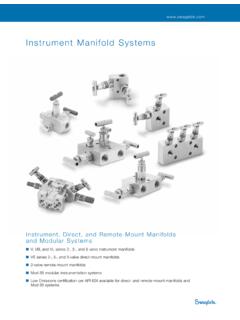Transcription of Grounding Techniques for Tactical Equipment and Systems
1 TC (TC 11-6) Grounding Techniques for Tactical Equipment and Systems DISTRIBUTION RESTRICTION. Approved for public release; distribution is unlimited. Headquarters, Department of the Army NOVEMBER 2017 This publication is available at the Army Publishing Directorate site ( ), and the Central Army Registry site ( *TC Restriction: Approved for public release; distribution is unlimited. *This publication supersedes TC 11-6, dated 3 March Training Circular No. Headquarters Department of the Army Washington, DC, 22 November 2017 Grounding Techniques for Tactical Equipment and Systems Contents Page PREFACE .. iiiINTRODUCTION .. ivChapter 1 TYPES OF GROUNDS .. 1-1 Basic Grounding Systems .. 1-1 Chapter 2 Grounding Systems .. 2-1 Purpose of Grounding Systems .. 2-1 Earth Grounding system Key Components .. 2-1 Chapter 3 SOIL CONDITIONS.)
2 3-1 Soil Types .. 3-1 Chapter 4 TERRAIN AND CLIMATE CONDITIONS .. 4-1 Terrain Types .. 4-1 Soil Resistivity .. 4-4 Chapter 5 HELPFUL HINTS .. 5-1 Grounding Tips .. 5-1 Reminders for Grounding .. 5-4 Appendix A Grounding CHECKLIST .. A-1 GLOSSARY .. Glossary- 1 REFERENCES ..References- 1 INDEX .. Index- 1 Contents ii TC 22 November 2017 Figures Figure 1-1. Earth ground .. 1-2 Figure 1-2. Equipment ground .. 1-3 Figure 1-3. Chassis ground .. 1-4 Figure 2-1. Ground rod with terminal screw .. 2-2 Figure 2-2. Ground rod clamp .. 2-3 Figure 2-3. Wrap method .. 2-4 Figure 2-4. Driven head sectional ground 2-5 Figure 2-5. Ground rod and driver .. 2-6 Figure 2-6. Soaking ground rod installation with water .. 2-7 Figure 2-7. Ground rod removal with vehicle 2-8 Figure 2-8. Grounding plate installation .. 2-9 Figure 2-9.
3 Surface wire Grounding kit .. 2- 10 Figure 2-10. Surface wire Grounding kit installation .. 2- 11 Figure 3-1. Moisture content .. 3-2 Figure 3-2. Temperature .. 3-3 Figure 3-3. Chemical 3-4 Figure 4-1. Sandy or dry soil .. 4-1 Figure 4-2. Rocky or hard compact soil .. 4-2 Figure 4-3. Wet or moist soil .. 4-3 Figure 4-4. Frozen soil .. 4-4 Figure 5-1. Multiple Equipment Grounding .. 5-1 Figure 5-2. Improvised ground rod items .. 5-2 Figure 5-3. Fall of potential resistance method .. 5-4 Tables Table 2-1. American Wire Gauge Conductor Size Chart .. 2- 13 Table 3-1. Soil type and quality .. 3-1 Table 4-1. Soil type and resistance .. 4-4 Table A-1. Grounding checklist .. A-1 22 November 2017 TC iii Preface Training Circular (TC) provides various Grounding Techniques for Tactical communications Equipment and Systems including the Surface Wire Grounding Kit.
4 This TC is intended to supplement detailed Grounding and safety information found in doctrine publications and Equipment technical manuals. Grounding is a basic communications procedure, each Soldier should know how and why to perform Grounding procedures regardless of the Equipment they are operating. The principle audience for TC is all Army professionals and contractors who plan, operate, maintain, and use Grounding devices for Tactical Equipment and Systems . This publication provides Grounding Techniques information and guidance to commanders, staffs, operators, and maintainers that execute oversite Grounding procedures for the Army. TC provides a significant resource to Army trainers and educators. Commanders, staffs, and subordinates ensure their decisions and actions comply with applicable Unites States, international, and in certain cases, host nation laws and regulations.
5 Commanders at every level ensure their Soldiers operate according to the laws of war and the rules of engagement. (See FM 27-10.) Additionally, Commanders and subordinate leaders ensure that all members of the Army Profession are expected to live by, adhere to, and uphold the moral principles of the Army Ethic. The training objective is for trusted Army professionals to accomplish their missions in the right way; ethically, effectively, and efficiently. Commanders and subordinate leaders, as moral exemplars and stewards of the Army profession, understand that their leadership facilitates the command climate, shared understanding, and mutual trust necessary to develop cohesive teams of trusted Army professionals (ADRP 1). TC uses joint terms where applicable. Selected joint and Army terms and definitions appear in both the glossary and in the text; the term is italicized and the number of the proponent publication follows the definition.
6 This publication is not the proponent for any Army terms. For other definitions shown in the text, the term is italicized and the number of the proponent publication follows the definition. TC applies to the Active Army, Army National Guard, Army National Guard of the United States, and United States Army Reserves unless otherwise stated. The proponent of TC is the United States Army Cyber Center of Excellence. The preparing agency is the Cyber Center of Excellence Doctrine Branch and United States Army Cyber Center of Excellence. Send comments and recommendations on a Department of Army Form 2028 (Recommended Changes to Publications and Blank Forms) to Commander, United States Cyber Center of Excellence, ATTN: ATZH-DT (TC ), 506 Chamberlin Avenue, fort Gordon, GA 30905-5735; by e-mail to TC 22 November 2017 Introduction This training circular is a guide to proper earth Grounding methods and procedures for use with Tactical Systems .
7 It describes different earth Grounding Systems and provides guidance on the proper methods for their installation. Earth Grounding helps to protect personnel and Equipment from electrical faults and power surges. Earth Grounding also helps reduce circuit noise and other transmission interference that can degrade communications-electronics system performance (CECOM TR 98-6). The instructions contained in this circular are designed to supplement information not often found in technical manuals. It will help in setting up effective and safe earth Grounding Systems for Tactical Equipment , Systems , and shelters. The procedures outlined in this training circular can assist in solving Grounding problems which may be encountered. For detailed Grounding procedures, consult the specific manual on the Tactical Equipment or Systems being operated or installed.
8 Failure to ground Equipment or improper Grounding can lead to serious injury or death. The Equipment is also subject to catastrophic failure from electricity surges. Improper Grounding can lead to burned-out circuit cards or complete destruction of a piece of Equipment or the entire system may become non-mission capable. TC contains five chapters: Chapter 1 covers the three basic types of Grounding Systems . Earth ground, Equipment ground, and chassis ground. Chapter 2 describes the many Techniques used for Grounding . Such as rods, plates, and wires contacting the earth. This chapter explains each system , recommends materials and kits to use, and how to install the system you select. Chapter 3 explains the different types of soil conditions that a Soldier may find in a Tactical operation for the employment of Equipment and Systems that need to be grounded.
9 The kinds of soil, its moisture content and temperature all affect how well the Equipment of system will operate. Chapter 4 discusses the different types of terrain and how it can affect Grounding procedures selected. Chapter 5 provides helpful hints and additional information that will help the user if Grounding procedures become a problem. Appendix A provides a general Grounding checklist that can be utilized by commanders, staffs, leaders, and Soldiers for their Equipment and Systems that require an earth ground. 22 November 2017 TC 1-1 Chapter 1 Types of Grounds This chapter covers the three basic Grounding Systems : earth ground, Equipment ground, and chassis ground. BASIC Grounding Systems 1- 1. All Soldiers need to keep basic Grounding Techniques and procedures in mind prior to employment of their communication and electronic Equipment .
10 Failure to perform basic Grounding Techniques could lead to Equipment failure, network outages, and ultimately personnel injury or death. EARTH GROUND 1- 2. In order to protect communications and electronic Equipment from built up or induced electrical charges or lightning strikes, provide a metal path to earth ground. Charges that can build up or be induced onto Equipment or are exposed to external high voltages are sent harmlessly into the earth if all the fundamental pieces of an effective Grounding system are used. 1- 3. An earth Grounding system helps to keep the electrical potential on noncurrent-carrying metal surfaces at a similar level as that of the surrounding earth. Earth Grounding is only part of the overall ground system . The other is to ensure that all Equipment and power supplies in the Equipment , shelter or system are bonded with a common Equipment Grounding conductor.














